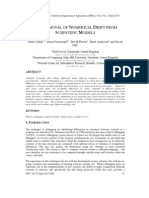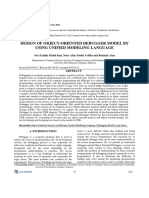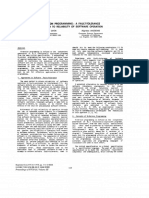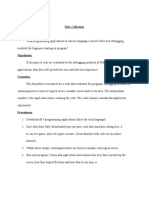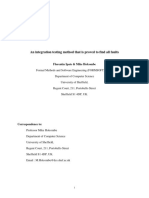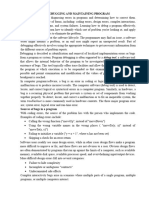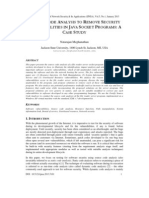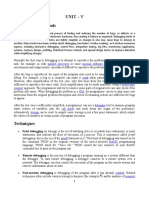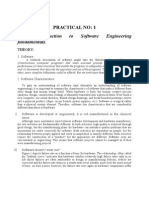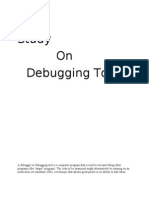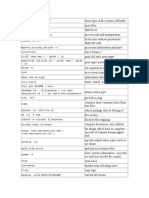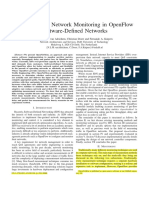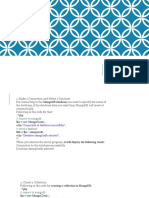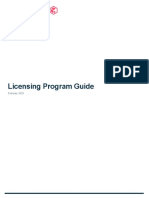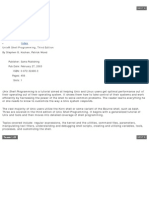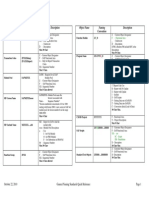CASE-95, 7th International Workshop on Computer-Aided Software Engineering, Toronto, Ontario, Canada, July 1995,
A Debugging Tool for Software Evolution
D. Abramson R. Sosic School of Computing and Information Technology Griffith University Kessels Rd, Brisbane, Queensland, 4111 {davida, sosic}@cit.gu.edu.au Phone: +61-7-875 5049 Fax: +61-7-875 5051
ABSTRACT This paper describes a tool for debugging programs which have been developed using evolutionary software techniques. The tool enhances the traditional debugging approach by automating the comparison of data structures between two running programs. Using this technique, it is possible to use early versions of a program which are known to operate correctly to generate values for comparison with the new program under development. The tool allows the reference code and the program being developed to execute on different computer systems by using open distributed systems techniques. A simple visualisation system allows the user to view the differences in data structures. By using the data flow of the code, it is possible to locate faulty sections of code rapidly. A small case study of finding an error in a scientific code is given. that software tools are available to simplify the process as much as possible. CASE environments incorporating tools such as source code control systems like SCCS [1] and RCS [2]; program dependency tools like Make [1]; and machine independent libraries can be effective in assisting the development process. Examples of the latter include graphical user interfaces like X [3], which are available on a range of platforms, and thus provide a high level of infrastructure on different systems. In combination with standard programming languages, these tools are quite effective and can increase productivity significantly. However, debuggers such as dbx [4, 5, 6] and gdb [7], and others [8, 9, 10, 11, 12] do not emphasise the debugging and testing of applications developed with evolutionary engineering techniques. Debuggers of this type allow the user to manipulate the new program through process control commands, and to examine and modify the state of the program. In debugging the program, the user must determine possible modes of failure, and then stop the execution at key points to examine the state. In determining whether the state is correct or not, the user must be able to predict the state values. The prediction is usually based on a detailed knowledge of the operation of the code. This can be extremely difficult for complex codes, especially if the person performing the debugging is not the author of the original program. In this paper we discuss a new debugging tool which can be used to test programs which are developed by evolution. Our tool incorporates conventional debugger commands as well as a new set of commands which facilitate comparison of the new program with an existing version. The paper begins with a discussion of the current techniques used to test evolutionary
1. INTRODUCTION
The high cost of software development, in combination with advances in software engineering, has caused the emergence of a software development methodology based on evolution. In this methodology, new programs are built from existing ones, utilising sections of code from old programs which perform functions required in the new application. The methodology is most commonly applied when the functionality of a program is expanded incrementally, and also when code is ported from one system to another. In the latter case, the old code is moved to a new platform with as little modification as possible. However, this simple minded approach often fails. For example, it may be necessary to modify sections of code which are system dependent, and in some circumstances it may even be necessary to rewrite the entire program in another programming language. Further, subtle differences in the semantics of programming languages and operating systems means that the code may behave differently on two systems. Because of these practical considerations, it is desirable
�programs. It then describes Guard1 (Griffith University Relative Debugger), a new debugger developed at Griffith University. Finally, we give an example of the use of Guard through a case study.
2. HOW DO WE TEST AND DEBUG EVOLVING PROGRAMS?
A common life cycle for a program developed using evolutionary engineering techniques is shown in Figure 1. It often begins as a small program for testing some basic functionality and design. It may be augmented and incrementally expanded into a large software system, and some of the core algorithms may even be altered. These types of modifications can be attributed to changes in the functionality or operation of the code. The program may be converted for execution on different hardware and software platforms, and may even be re-written in another language to allow it to take advantage of new hardware. These types of modification can be classified as migratory ones. Regardless of the cause of the changes, at each of these stages the programmer must determine whether the program is still operating correctly, and if not, must determine which of the alterations caused the new behaviour.
The most common technique for testing and debugging evolved programs is to use the data flow of the code to locate the point at which the data structures in the new program diverge from those in the existing one. Thus, the existing code acts as a reference version by defining a set of expectations. In this way, the user typically works back to determine the last point at which the data was correct by comparing data structures with the reference version. Once this point has been established, most errors can be traced quickly to a small section of faulty code, and the error can be corrected. Debugging real programs using this technique and currently available tools can be tedious and error prone. Typically, output statements are placed in both the reference and the debugged code, and the values are either compared by visual inspection, or by a file comparison program [13]. If the two programs execute on different computer systems then the data must be transferred before it can be compared. Because of these shortcomings, we have developed a new debugging tool, and this will be described in the next section.
3. Guard: A RELATIVE DEBUGGER
3.1 What is Guard? Guard is a distributed debugger which operates in an open heterogenous computing environment [14, 15]. Guard provides the user with functionality to control more than one program and to make assertions about the correctness of a new program with reference to an existing one. Consequently, Guard supports the evolution of programs because it acknowledges the existence of working versions of the code. Figure 2 shows the way that Guard interacts with both the reference code and the code being debugged. Because Guard works in a distributed environment, it is possible to execute the reference code, the program being debugged and Guard itself on three different computer systems, as shown in Figure 2. Guard communicates with the programs it is controlling via a network and makes use of special network support libraries linked with the applications. Guard relies on the premise that differences between the data structures in the reference code and the one being debugged can be used to detect faults. This assumes that the two programs utilise comparable data structures, or at least provide a set of conversion routines which makes them appear equivalent. Guard makes no assumptions about the control flow of the two programs, which may be different. It requires the user to determine key points in the two programs at which various data structures should be equivalent.
Migration
Functional Changes
Original program
Program rewritten in another language for new hardware
Program ported to another computer system
Augmented Program with new ideas
Core algorithms altered
Figure 1 - Typical life cycle of software system Currently, there are very few tools which assist porting and debugging evolving programs across different hardware and software platforms. Traditional debuggers have a number of severe limitations which significantly reduce their applicability. The most serious limitation is that they are incapable of dealing with several programs running at the same time and possibly on different computers. They have no facilities for comparing the output and internal state of different programs, which must be done by tedious and error prone manual methods.
1 Patent Pending
�Machine 1
Machine 2 Program being debugged
Machine 3
Reference Program
Guard Debugger Support Library Debugger Support Library
Computer Network
Figure 2 - Guard - A relative debugger the faulty region, such as a binary search, can be very effective. 3.2 Network independent debugging G u a r d makes use of open distributed processing techniques to allow the reference code and the debugged code to execute concurrently on different computer systems. This means that when a code is being ported to another system, the reference code operates in an environment which is known to produce the correct results. Consequently, the user is able to concentrate on the causes of deviation of the debug code. Network location information is restricted to the Guard command invoke, which starts executing a process. In this command a local name is bound to the process for use in future commands. After the invoke command has been issued, all other Guard commands use the logical name when referring to the process. 3.3 Using Guard Guard relies on the user to make a number of assertions which compare data structures in the debugged code and the reference version. These assertions make it possible to detect faulty code because they indicate where (and when) the data structures deviate from those in the reference code. The choice of data structures and test points must be determined by the user based on some knowledge of the application. It is not necessary to test all data structures, but only those which will help uncover the source of the error. Likewise, it is not necessary to test the structures after each executable statement. A search which refines Guard can be used in two modes: one in which the assertions are specified declaratively, and the other using procedural techniques. The procedural scheme relies on the user manually placing breakpoints in both the reference code and the debugged code. These are planted at key test points. Both programs are then executed until they reach these breakpoints, after which the user tests the equality of arbitrary data structures using a compare statement. The following example shows the syntax of the compare statement by comparing the values of variable test in the reference code and the debug code. In this example, reference and debug are names which are bound to the two processes under examination by the invoke command. compare reference::test = debug::test If the two data structures are not equivalent, then the nature of the error is reported. If the variables are simple types like integer or real, then it is possible to report the two values. If they are compound structures like arrays, then the location of the difference in the two structures must be reported as well. In a future section we will describe the exact method of reporting differences for array type structures. The user can then resume execution of the two programs using a continue statement. It is possible to compare a number of data structures after the breakpoints have been reached, and also new breakpoints can be set to further refine the erroneous code. This process closely resembles the way a conventional debugger is used. However, it allows the user to control two processes concurrently and compare data structures. This manual scheme can become unwieldy on large programs because there are two processes to control.
�Further, it is not well suited for using the debugger to automatically test whether a new version of program conforms to the previous one, because it requires a great deal of user interaction. Consequently, we developed another, automatic, mode of operation called declarative assertions. Declarative assertions allow the user to bind a set of breakpoints to comparison operations at any time prior to or during execution of the code. In this way, the comparisons are invoked automatically each time the breakpoints are reached. If the compare statements do not detect an error, then the code is automatically resumed without any user interaction. Declarative assertions provide a convenient mechanism for stating a set of conditions for correct execution, and thus are well suited for automatically testing a new program against previous versions. If the assertions do not cause any errors, then the code is known to conform to previous versions. Declarative assertions are also effective when an error is detected only after a number of iterations of a particular statement. Because the user is not involved until an error is detected, little user interaction is required to actually detect the erroneous lines. The following syntax is used to declare an assertion: assert reference::variable1@line1 = debug::variable2@line2 where reference and debug are bound to the two processes as discussed previously, variable1 and variable2 are arbitrary variables in the programs, and line1 and line2 are source code line numbers. Later in the paper we will illustrate the use of declarative assertions for detecting errors in a large scientific modelling program. 3.4 Data Types Like conventional debuggers, Guard needs to understand the types of variables in the programs it controls. On many systems (e.g. Unix) the type information is embedded in special symbol table information stored in the executable image. This can be automatically extracted by the debugger at the beginning of a debug session. In a conventional debugger, this information allows it to display variables in a way which is meaningful to the programmer. In Guard, the information is also required so that it knows how to compare variables. For example, variables must be type compatible before they can be compared. Further, Guard needs to understand the structure of the variables during the comparison operation so that it can traverse the basic elements. Other complications arise because the reference code may execute on a system with different attributes from the code being tested. For example, byte
ordering may differ and the two programs may even be written in different languages. Consequently, Guard must map types from one system onto another. Guard currently handles variables of base types integer, real, character and multi dimensional arrays of these base types. The base types are compared for equality. Arrays are compared by traversing each of the indices in order, and differences are reported together with their position information. This allows Guard to compare arrays in programming languages which use different ordering, such as Fortran and C. Guard allows also comparison of sub-arrays . These base types have been sufficient to demonstrate the effectiveness of Guard in debugging a number of large scientific programs. In future versions of Guard we will add support for data types such as records and dynamic structures like linked lists. The latter requires sophisticated procedures for mapping the data structures into an intermediate form prior to comparison and for interpretation of this intermediate form. 3.5 Tolerances A program may not be in error simply because its variables do not exactly match those of a reference version. The most obvious example of this is when the two systems use difference floating point representations or libraries. In this case numbers may be deemed to be equivalent if they are within a predefined tolerance of each other. Accordingly, G u a r d includes a user controlled tolerance threshold, below which numbers are considered equivalent. Further, individual assertions may specify their own threshold rather than using the global one. To allow the user to explore the way in which two variables differ it is possible to vary the threshold through a slider control. This allows the user to view the maximum regions without explicitly requesting the values. 3.6 Displaying the results If two scalar variables differ then it is possible to display the two values and report the difference. However, when complex data structures differ it is difficult to interpret the cause of the error by viewing the numeric values alone, particularly if they are floating point numbers. Consequently, we have developed a simple visualisation system for Guard which uses a pixel map to show when corresponding values of array type data structures are not the same. Guard also reports the maximum and average differences between arrays as numeric values.
�Figure 3 - Numeric instability causing errors
Figure 4 - Incorrect loop bound arrays. We have not yet considered suitable display The most intuitive display is formed when two methods for dynamic data structures. dimensional arrays are visualised. In this case, a two dimensional pixel map is created in which each pixel Figures 3 and 4 show some sample visualisations which corresponds to one array element. In this way errors were produced by Guard when it was used for testing a which are caused by incorrect loop bounds and strides are new version of the Shallow Water Equations [16]. The obvious because regular patterns are created. Guard original code was written in FORTRAN and the new currently maps all other shaped arrays onto two version was written in C and ran on a different computer dimensional ones by either expanding the one system. Figure 3 shows the effect of floating point dimensional arrays or merging higher dimensions. It is differences between two of the two dimensional data our intention to experiment with three dimensional structures used to hold the pressure of the wave. In both visualisation techniques to show three dimensional visualisations, a black pixel means that the data is difference patterns, as well as colour for higher order different at the specified row and column of the arrays.
�From Figure 3 it can be seen that the two data structures are drifting apart due to numeric errors because many of the values are incorrect, but the maximum difference is quite small (4.3 x 10-06). Figure 4 shows the effect of a
Structure Initialise Data Structures Airshed.F
wrong loop bound in the new code. The section of the array which has not been calculated can be clearly seen as a band of black pixels covering the missing columns on the right.
PROGRAM AIRSHED
Line 1849 DO 570 ICOLM = 1, ... Loop for all columns of 3D space Perform chemistry with hourly values for wind vectors Perform simulation for required number of hours Solve Chemistry and vertical mixing for one column of 3D space
Line 1906
Assertion (1) CORRECT
CALL COLLOOP(, , C, ,
570 CONTINUE
Perform transport in x direction Line 1931
Assertion (2) INCORRECT
Perform transport in y direction
Read new set of hourly wind vectors
Assertion (3) INCORRECT
Line 2071 END
4. A CASE STUDY
Figure 5 - Overall structure of code plus source in Airshed.F memory allocation. However, it also makes the code harder to understand and debug.
In this section we describe an application of Guard for finding a subtle error in a scientific code. The program, a photo chemical pollution code, models the chemical processes which occur during smog formation [17]. It has been used as part of a number of real world studies involved with formulating pollution control strategies. Table 1 shows the characteristics of the software, which are typical of many other scientific modelling programs. One of the key data structures in the program is an array, named C, which holds the concentrations of all chemical species for each of the cells in three dimensional space. The array is conceptually indexed by two co-ordinate indices (column number in 2D space and vertical level) and a chemical species number. Whilst this would normally require a three dimensional array, it is actually represented as a one dimensional array. This assists with the vectorisation of the program, and also with dynamic
Language Lines of code Number of source modules
Fortran 15,000 15
Table 1 - Characteristics of Smog Model In this study we show how Guard was used to track an error in the numeric integration code. The problem was detected after the program failed to generate correct results for a particular simulation. A reference version of the code was established and used for the comparison of key data structures. Whilst both versions were run on the same computer, it would have been possible to execute them on different networked systems.
�assert Figure 5 shows basic computational structure of the program at the outer level. After initialising the key data structures the program enters a loop in which the concentrations of each of the chemical species are calculated at discrete time steps. The program works on sections of the concentration vector (C) corresponding to each column of the 3 dimensional space. Once the new concentrations have been computed horizontal transport is performed in 2 directions. The program uses a set of hourly wind vector values a number of times before reading in a new set of vectors. These operations are mostly performed in the source file airshed.F. The assertions shown in Figure 6 were used to determine the point at which the concentration vector (C) became corrupt. As discussed earlier, the assertions were placed at strategic places in the code to try and locate where the C vector became corrupt. These assertions detect that the vector C was incorrect at lines 2071 and 1931 but still correct at line 1906. Consequently, the error must be contained in the routine COLLOOP.
assert
assert
old::C@airshed.F:1906 = new::C@airshed.F:1906 Assertion(1) old::C@airshed.F:1931 = new::C@airshed.F:1931 Assertion(2) old::C@airshed.F:2071 = new::C@airshed.F:2071 Assertion(3)
Figure 6 - Assertions relating to Airshed.F Figure 7 shows the structure and source of the routine COLLOOP. The appropriate cells from C are copied to a temporary concentration vector called CNT. The new concentrations for the species are calculated by solving the ordinary differential equations which govern the rates of production of each chemical species. Then the concentrations are adjusted to take account of vertical mixing in the column. These two operations are mostly performed in colloop.F. The assertions shown in Figure 8 were used to conclude that the values in CNT were correct at line 305 and incorrect at line 321. Consequently, the error must be contained in the routine INTEGR2.
Structure Copy part of C to CNT Solve differential equations for column in CNT Perform vertical transport within column CNT
Colloop.F SUBROUTINE COLLOOP( .... ) Line 255 Copy part of C to CNT
Assertion (1) CORRECT
Line 305 CALL INTEGR2(, CNT, , ,)
Assertion (2) INCORRECT
Copy CNT to part of C Line 321 Copy CNT back to C Line 412 RETURN
Figure 7 - Structure and code of COLLOOP in Colloop.F assert old::CNT@colloop.F:305 = new::CNT@colloop.F:305 Assertion(1) old::CNT@colloop.F:321 = new::CNT@colloop.F:321 Assertion(2) Figure 9 shows the structure and code of the routine INTEGR2, which performs a numeric integration. This makes use of a number of working vectors (such as C3). Figure 10 shows the assertions related to INTEGR2. These assertions determine that C3 was incorrect at 711 and 595, but the switch variable IS was correct at line 587. From the information gathered by these assertions the error was found at line 587 of numerics.F as shown in Figure 11.
assert
Figure 8 - Assertions relating to Colloop.F
�Structure
Numerics.F SUBROUTINE INTEGR2( ... ) Line 587 IF(IS(I) .GT.0) GO TO 70
Assertion (1) CORRECT
Compte new concentrations using working vector C3 Copy new concentrations back to CNT
Line 591 Line 595 Line 711
Compute C3 based on CNT 70 CONTINUE RETURN
Assertion (2) INCORRECT
Assertion (3) INCORRECT
Figure 9 - Structure and code of INTEGR2 in Numerics.F developed with evolutionary software engineering techniques. The tool recognises previous versions of a assert old::IS@numerics.F:587 = program and allows comparison of data structures new::IS@numerics.F:587 between new and old versions. Because it operates in a Assertion(1) distributed heterogenous environment it is ideal for use in assert old::C3@numerics.F:595 = program porting because the original implementation can new::C3@numerics.F:595 act as a reference site. Through a simple case study, we Assertion(2) have illustrated the power of the system. assert old::C3@numerics.F:711 = new::C3@numerics.F:711 Guard is also useful for automatically testing new Assertion(3) versions of programs against existing ones. The declarative assertion makes it possible to specify a Figure 10- Assertions relating to Numerics.F number of assertions about key data structures before any changes are made to the code, and the program can be executed under the control of the debugger to verify these IF (IS(I).GT.0) GO TO 70 that these assertions are met. In this paper we have ignored a number of high level features of Guard, such as Correct partial assertion lists and generation of trace files. These two features are important because they simplify this IF (IS(I).LT.0) GO TO 70 automatic process. More details can be found elsewhere [15]. Incorrect Current research involves expanding Guard to support the testing of parallel programs, supporting more data Figure 11 - Correct and incorrect source in numerics.F types and increasing the range of data structure visualisations which are possible. The tool has been This error caused only some of the array elements to be ported to SUN, Next and Silicon Graphics machines, and incorrect, and would have been extremely difficult to a port to IBM RS6000 is nearly complete. We are trace using a conventional debugger. The difference planning a parallel version for the IBM SP2 during 1995. visualisations allowed the error to be detected very quickly using a simple search in combination with the data flow in the code. With these assertions in place the Acknowledgments incorrect code was located after some 2-3 minutes of execution time. One of the main attractions of Guard was This work has been sponsored by the Australian that it was not necessary to alter the code during the Research Council. The authors wish to acknowledge the debugging phase, and thus new assertions could be work of Lisa Bell, who has performed most of the developed and refined without the need to recompile the programming necessary to implement Guard. Thanks go code. to Simon Wail from IBM for proof reading a draft of this paper.
5. CONCLUSION AND FUTURE DIRECTIONS
In this paper we have described a new tool which supports the debugging and testing of programs
References
[1] Programming Utilities and Libraries', Sun Release 4.1, Sun Microsystems, 1988.
�[2]
Walter F. Tichy, "RCS-A System for Version Control", Software-Practice & Experience 15, 7 (July 1985), 637-654. A. Nye, Xlib Programming Manual, O'Reilly & Associates, Sebastopol, CA, 1989. 'Debugging Tools Manual', Sun Release 4.1, Sun Microsystems, 1990. E. Adams and S. S. Muchnick, 'Dbxtool: a window-based symbolic debugger for Sun Workstations', SoftwarePractice & Experience, 16, (7), 653-669 (1986). M. A. Linton, 'The evolution of Dbx', Proceedings of the Summer 1990, USENIX Conference, June 1990, pp. 211220. R. M. Stallman, GDB Manual, Free Software Foundation, Cambridge, MA. T. G. Moher. "PROVIDE: A process visualization and debugging environment", IEEE Transactions on Software Engineering, 14(6):849-857, June 1988. R.A. Olsson, R. H. Crawford, and W. W. Ho."A dataflow approach to event-based debugging", Software-Practice and Experience, 21(2):209-229, February, 1991.
[17] McRae G.J., Russell A.G. and Harley R.A., 1992. CIT photochemical airshed model -users manuals, Carnegie Mellon University, Pittsburgh, PA and California Institute of Technology, Pasadena, CA.
[3] [4] [5]
[6]
[7] [8]
[9]
[10] N.Ramsey and D.R. Hanson. "A retargetable debugger"., Proceedings of SIGPLAN'92 Conference on Programming Language Design and Implementation, pages 22-31. ACM, 1992. [11] E.Satterthwaite."Debugging tools for high level languages", Software-Practice and Experience, 2(3):197217, July-September 1972. [12] D. Cheng and R. Hood, "A Portable Debugger for Parallel and Distributed Programs", Proceedings of Supercomputing 94, Dec 94. [13] N. Galbreath, W. Gropp, and D. Levine "Applicationsdriven parallel I/O", Proceedings Supercomputing-93, Portland, Oregon, pages 462-471. IEEE, 1993. [14] D.A. Abramson. and R. Sosic, "Relative Debugging: A new debugging paradigm", Griffith University Technical Report, School of Computing and Information Technology, Report # CIT-94-13. [15] Sosic, R. and Abramson, D. A. "Guard: A Relative Debugger", Griffith University Technical Report, School of Computing and Information Technology, Report # CIT94-21. [16] D.A. Abramson, M. Dix, P. Whiting. "A Study of the Shallow Water Equations on Various Parallel Architectures", 14th Australian Computer Science Conference, Sydney, 1991.

